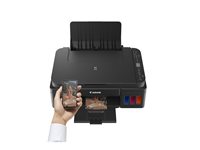
To solve these problems, I adopted a helicoid design for the focusing barrel and integrated the EOS mount, so there was no need to glue one on. I also had a fear that the glue at the base and the M42 adapter would fail and sheer the lens from the camera. This led me to relying on moving myself rather than the lens to get images in focus. Moving a heavy, awkward shaped lens *just* the right amount to get an image in focus was difficult, as I found I would pull the lens too far out of the barrel or push too far inward. However, it was difficult to obtain accurate focus as it was tedious to use.

The focal range was correct for just a guess, and I was able to take plenty of interesting photos with it. To my surprise everything fit well and worked! Focus was obtained by sliding the lens further or closer to the camera, like using a handheld telescope. After a bit of sanding and cleanup, I glued the M42 adapter to the outer female base, pressed the male side of the adapter over the rear of the lens, and then slid over the female side of the adapter. I exported the models and 3D printed them in black PLA. I also added an base to the bottom outer diameter, which would allow me to glue an M42 to EOS adapter to it, so it could be mounted to the camera. Fortunately, it was just another tube with an inner diameter slightly larger than the male tubes outer diameter, allowing it to slide freely when inserted. With what I’ll call the male side complete, I began work on its female counterpart. This allowed the tube to be pressed over the rear of the lens, about a 8mm down, and held in place via friction. My initial design was a simple barrel focusing system, so I began by modeling a few tubes in CAD easy, right? The first tube was 40mm long, and the inner diameter was only a hair larger than the rear outer diameter of the lens barrel.

It was crude, unsafe, and dumb but it worked! Now I needed to design an adapter that would be a little less crude than this setup. To my surprise, I could see, and I could vary the focus by changing the distance between the lens and the camera. With the camera now in live mode I held the Isco lens about an inch or so in front of the hole where a lens should be attached. Screwing just the M42 adapter into my DSLR allowed me to use live mode with no lens attached. I don’t give up very easily (yes, I do) so I decided to keep going.

Fueled by curiosity, I removed the M42 to EOS adapter from Helios lens and attempted to attach it to the rear of the Isco lens with tape, which didn’t work (surprise, surprise). Measuring and comparing the rear elements and lens diameters with calipers confirmed that they were nearly identical to each other. The Helios 44/2 is a vintage Soviet lens and M42 is a lens screw mount that was common on older film SLRs, and it is easily adapted to most modern DSLRs. The rear diameter of the lens and element looked similar in size to that of my Helios 44/2, which uses an M42 mount. With the lens now removed, cleaned and still the same gargantuan hunk of glass and metal it was beforehand, it was time to see if it could even work on a modern DSLR. After a quick clean of the glass, I began to think “how the hell am I going to attach this thing to my camera?”. The aperture is fixed at f3.5 and the focal range is an adjustable 300-400mm. The lens is nearly a foot long, the front glass has a diameter of four inches and it is HEAVY.


 0 kommentar(er)
0 kommentar(er)
